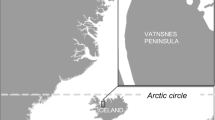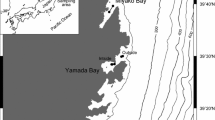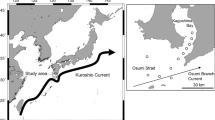Abstract
Knowledge of the dietary choices of organisms is the key to understanding their roles in ecosystems, which plays an important role in conservation of species that are vulnerable to overexploitation. Finless porpoise Neophocaena asiaeorientalis sunameri is one of the most endangered marine mammalian. In this study, the dietary composition were analyzed in 23 samples of finless porpoise collected across its distributing range. The prey species was identified using morphological and mitochondrial COI barcoding analyses. A total of 21 species including 16 fish, 2 cephalopods, 2 crustaceans, and one bivalve were identified based on both two methods. However, mtDNA barcoding increased taxonomic resolution and revealed more 9 taxa than morphological traits. For the quantitative analysis of the dietary, Odontamblyopus lacepedii, Scomber australasicus, Larimichthys polyactis, Nibea albiflora and Saurida elongate were dominant. Moreover, geographical variation in prey composition was observed comparing with previous studies. Our reports offered important information in understanding biological habits of finless porpoise which is crucial in conservation of the species.




Similar content being viewed by others
References
Alonso H, Granadeiro JP, Waap S, Xavier J, Symondson WOC, Ramos JA, Catry P (2014) An holistic ecological analysis of the diet of Cory’s shearwaters using prey morphological characters and DNA barcoding. Mol Ecol 23:3719–3733
Barnett A, Redd KS, Frusher SD, Stevens JD, Semmens JM (2010) Non-lethal method to obtain stomach samples from a large marine predator and the use of DNA analysis to improve dietary information. J Exp Mar Biol Ecol 393:188–192
Barros NB, Jefferson TA, Parsons ECM (2002) Food habits of finless porpoises (Neophocaena phocaenoides) in Hong Kong waters. Raffles Bull Zool Suppl 10:115–123
Cherel Y, Hobson KA, Guinet C, Vanpe C (2007) Stable isotopes document seasonal changes in trophic niches and winter foraging individual specialization in diving predators from the Southern Ocean. J Anim Ecol 76:826–836
Cristóbal-Azkarate J, Arroyo-Rodrígez V (2007) Diet and activity pattern of howler monkeys (Alouatta palliata) in Los Tuxtlas, Mexico: effects of habitat fragmentation and implications for conservation. Am J Primatol 69:1013–1029
De Barba M, Miquel C, Boyer F, Mercier C, Rioux D, Coissac E, Taberlet P (2014) DNA metabarcoding multiplexing and validation of data accuracy for diet assessment: application to omnivorous diet. Mol Ecol Resour 14(2):306–323
Deagle BE, Tollit DJ (2007) Quantitative analysis of prey DNA in pinniped faeces: potential to estimate diet composition? Conserv Genet 8:743–747
Deagle BE, Kirkwood R, Jarman SN (2009) Analysis of Australian fur seal diet by pyrosequencing prey DNA in faeces. Mol Ecol 18(9):2022–2038
Folmer O, Black M, Hoeh W, Lutz R, Vrijenhoek R (1994) DNA primers for amplification of mitochondrial cytochrome. Mol Mar Biol Biotech 3:294–299
Gosch M, Hernandez-Milian G, Rogan E, Jessopp M, Cronin M (2014) Grey seal diet analysis in Ireland highlights the importance of using multiple diagnostic features. Aqua Biol 20(2):155–167
Hart RK, Calver MC, Dickman CR (2003) The index of relative importance: an alternative approach to reducing bias in descriptive studies of animal diets. Wildl Res 29:415–421
Hebert PDN, Barrett RDH (2005) Reply to the comment by L. Prendini on ‘Identifying spiders through DNA barcodes’. Can J Zool 83:505–506
Ivanova NV, Zemlak TS, Hanner RH, Hebert PDN (2007) Universal primer cocktails for fish DNA barcoding. Mol Ecol Notes 7:544–548
Jefferson TA, Wang JY (2011) Revision of the taxonomy of finless porpoises (genus Neophocaena): the existence of two species. J Mar Anim Ecol 4:3–16
Jefferson TA, Hung SK, Wursig B (2009) Protecting small cetaceans from coastal development: impact assessment and mitigation experience in Hong Kong. Mar Policy 33:305–311
Jia KT, Lin WZ, Gui D, Karczmarski L, Wu YP (2014) Molecular evidence reveals the distinctiveness of Indo-Pacific finless porpoise (Neophocaena phocaenoides) in the Pearl River Estuary and insights into genus Neophocaenaʼs origin. Mar Biol 161:1911–1930
Jin X (2004) Long-term changes in fish community structure in the Bohai Sea, China. Estuar Coast Shelf Sci 59:163–171
Jo HB, Gim JA, Jeong KS, Kim HS, Joo GJ (2013) Application of DNA barcoding for identification of freshwater carnivorous fish diets: is number of prey items dependent on size class for Micropterus salmoides? Ecol Evol 4:219–229
Kasuya T (1999) Finless porpoise Neophocaena phocaenoides (G. Cuvier, 1829. In: Ridgwag SH, Harrison R (eds) Handbook of marine mammals: the second book of dolphins and the porpoise, vol 6. Academic Press, San Diego, pp 411–442
Kimura M (1980) A simple method for estimating evolutionary rates of base substitutions through comparative studies of nucleotide sequences. J Mol Evol 16:111–120
Kress WJ, García-Robledo C, Uriarte M, Erickson DL (2015) DNA barcodes for ecology, evolution, and conservation. Trends Ecol Evol 30:25–35
Lin WZ, Frère CH, Karczmarski L, Xia J, Gui D, Wu YP (2014) Phylogeography of the finless porpoise (genus Neophocaena): testing the stepwise divergence hypothesis in the northwestern Pacific. Sci Rep–UK. doi:10.1038/srep06572
Liu BL, Chen XJ (2009) Review on the research development of beaks in cephalopoda. J Fisheries China 33:157–164 (in Chinese)
Liu BL, Chen XJ, Fang Z, Jin Y (2015) Species identification of cephalopods based on beak morphometric variables. Oceanologica et Limnologia Sinica 46:1365–1372 (in Chinese)
McGinnis S, Madden TL (2004) BLAST: at the core of a powerful and diverse set of sequence analysis tools. Nucleic Acids Res 32:20–25
Méheust E, Alfonsi E, Ménec PL, Hassani S, Jung JL (2014) DNA barcoding for the identification of soft remains of prey in the stomach contents of grey seals (Halichoerus grypus) and harbor porpoises (Phocoena phocoena). Mar Biol Res 11:385–395
Naito Y, Costa DP, Adachi T, Robinson PW, Fowler M, Takahashi A (2013) Unravelling the mysteries of a mesopelagic diet: a large apex predator specializes on small prey. Funct Ecol 27:710–717
Park KJ, Zhang CI, Sohn H, Kim ZG (2005) Feeding habits of finless porpoise (Neophocaena phocaenoides) in the west coast of Korea. Paper SC/57/SM17. IWC, Impington, Cambridge, United Kingdom
Pompanon F, Deagle BE, Symondson WOC, Brown DS, Jarman SN, Taberlet P (2012) Who is eating what: diet assessment using next generation sequencing. Mol Ecol 21:1931–1950
Ratnasingham S, Hebert PDN (2007) BOLD: the barcode of life data system (http://www.barcodinglife.org). Mol Ecol Notes 7:355–364
Reeves RR, Wang JY, Leatherwood S (1997) The finless porpoise, Neophocaena phocaenoides (G. Cuvier 1892): a summary of current knowledge and recommendations for conservation action. Asian Mar Biol 14:111–143
Ridoux V, Spitz J, Vincent C, Walton MJ (2007) Grey seal diet at the southern limit of its European distribution: combining dietary analyses and fatty acid profiles. J Mar Biol Assoc United Kingdom 87:255–264
Roura Á, González ÁF, Pascual S, Guerra Á (2010) A molecular approach to identifying the prey of cephalopod paralarvae. ICES J Mar Sci 67:1408–1412
Shirakihara M, Seki K, Takemura A, Shirakihara K, Yoshida H, Yamazaka T (2008) Food habits of finless porpoises Neophocaena phocaenoides in western Kyushu, Japan. J Mammal 89:1248–1256
Tamura K, Stecher G, Peterson D, Filipski A, Kumar S (2013) MEGA 6: molecular evolutionary genetics analysis version 6.0. Mol Biol Evol 30:2725–2729
Xu SX, Ren WH, Zhou XM, Zhou KY, Yang G (2010) Sequence polymorphism and geographical variation at a positively selected MHC-DRB gene in the finless porpoise (Neophocaena phocaenoides): implication for recent differentiation of the Yangtze finless porpoise? J Mol Evol 71:6–22
Ye ZJ. (2010) Study on otolith shape, taxonomy and application for fishes in China Sea. PhD Dissertation, Ocean University of China
Zarzoso-Lacoste D, Corse E, Vidal E (2013) Improving PCR detection of prey in molecular diet studies: importance of group-specific primer set selection and extraction protocol performances. Mol Ecol Resour 13:117–127
Acknowledgments
We deeply appreciate Mr. Xingkuan Du for collecting samples and Prof. Zhiqiang Han for his invaluable advices.
Funding
This work was supported by Department of Ocean and Fisheries of Liaoning Province under Grant Scientific Research Projects of Marine and Fisheries in Liaoning Province (201417).
Author information
Authors and Affiliations
Corresponding author
Ethics declarations
Conflict of interest
No potential conflict of interest was reported by the authors.
Additional information
Zhichuang Lu, Shengyong Xu contributed equally to this work.
Electronic supplementary material
Below is the link to the electronic supplementary material.
Rights and permissions
About this article
Cite this article
Lu, Z., Xu, S., Song, N. et al. Analysis of the diet of finless porpoise (Neophocaena asiaeorientalis sunameri) based on prey morphological characters and DNA barcoding. Conservation Genet Resour 8, 523–531 (2016). https://doi.org/10.1007/s12686-016-0575-2
Received:
Accepted:
Published:
Issue Date:
DOI: https://doi.org/10.1007/s12686-016-0575-2




